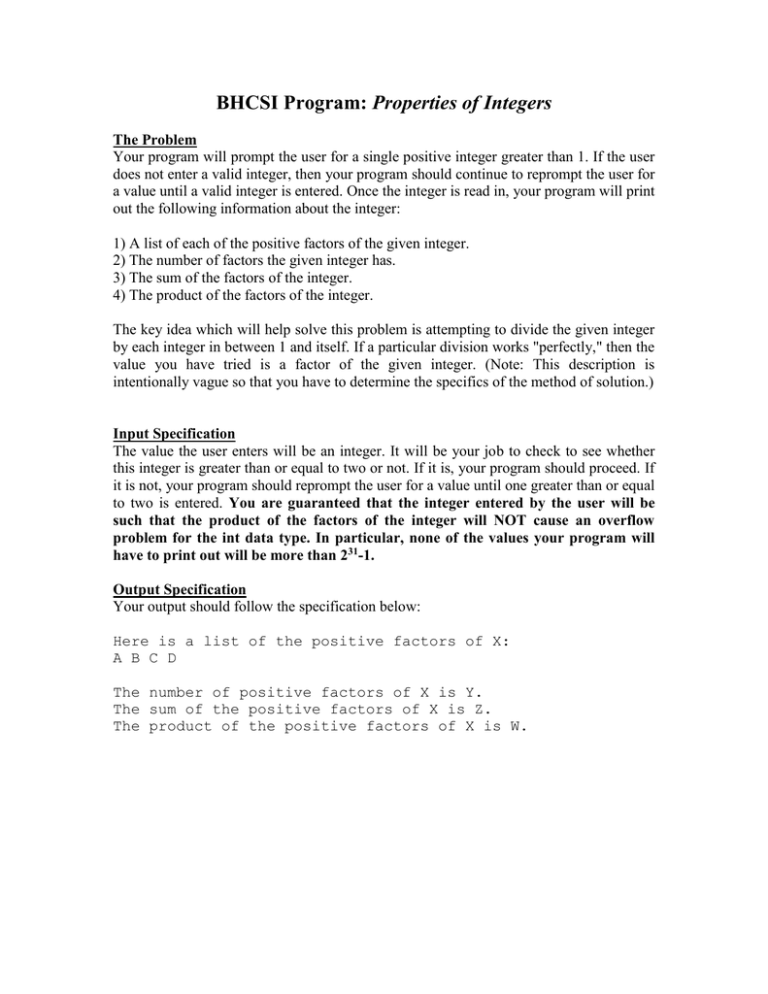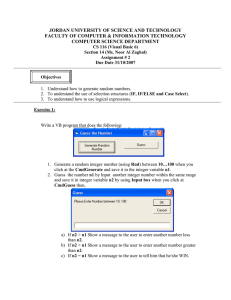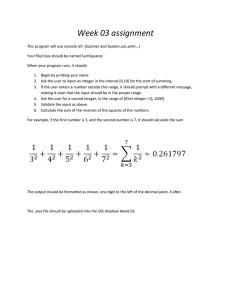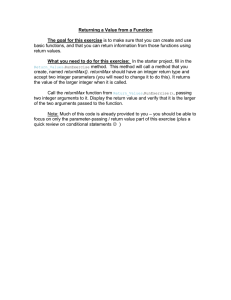Properties of Integers
advertisement

BHCSI Program: Properties of Integers The Problem Your program will prompt the user for a single positive integer greater than 1. If the user does not enter a valid integer, then your program should continue to reprompt the user for a value until a valid integer is entered. Once the integer is read in, your program will print out the following information about the integer: 1) A list of each of the positive factors of the given integer. 2) The number of factors the given integer has. 3) The sum of the factors of the integer. 4) The product of the factors of the integer. The key idea which will help solve this problem is attempting to divide the given integer by each integer in between 1 and itself. If a particular division works "perfectly," then the value you have tried is a factor of the given integer. (Note: This description is intentionally vague so that you have to determine the specifics of the method of solution.) Input Specification The value the user enters will be an integer. It will be your job to check to see whether this integer is greater than or equal to two or not. If it is, your program should proceed. If it is not, your program should reprompt the user for a value until one greater than or equal to two is entered. You are guaranteed that the integer entered by the user will be such that the product of the factors of the integer will NOT cause an overflow problem for the int data type. In particular, none of the values your program will have to print out will be more than 231-1. Output Specification Your output should follow the specification below: Here is a list of the positive factors of X: A B C D The number of positive factors of X is Y. The sum of the positive factors of X is Z. The product of the positive factors of X is W. Output Samples Here are three sample outputs of running the program. Note that this set of tests is NOT a comprensive test. You should test your program with different data than is shown here based on the specifications given. The user input is given in italics while the program output is in bold. Output Sample #1 Enter a positive integer greater than one. -100 Sorry, that input is not valid. Enter a positive integer greater than one. 9 Here is a list of the positive factors of 9: 1 3 9 The number of positive factors of 9 is 3. The sum of the positive factors of 9 is 13. The product of the positive factors of 9 is 27. Output Sample #2 Enter a positive integer greater than one. 12 Here is a list of the positive factors of 12: 1 2 3 4 6 12 The number of positive factors of 12 is 6. The sum of the positive factors of 12 is 28. The product of the positive factors of 12 is 1728. Output Sample #3 Enter a positive integer greater than one. 100 Here is a list of the positive factors of 100: 1 2 4 5 10 20 25 50 100 The number of positive factors of 100 is 9. The sum of the positive factors of 100 is 217. The product of the positive factors of 100 is 1000000000. Extra Query What is the relationship between the integer entered by the user, the number of factors that integer has and the product of those factors?



